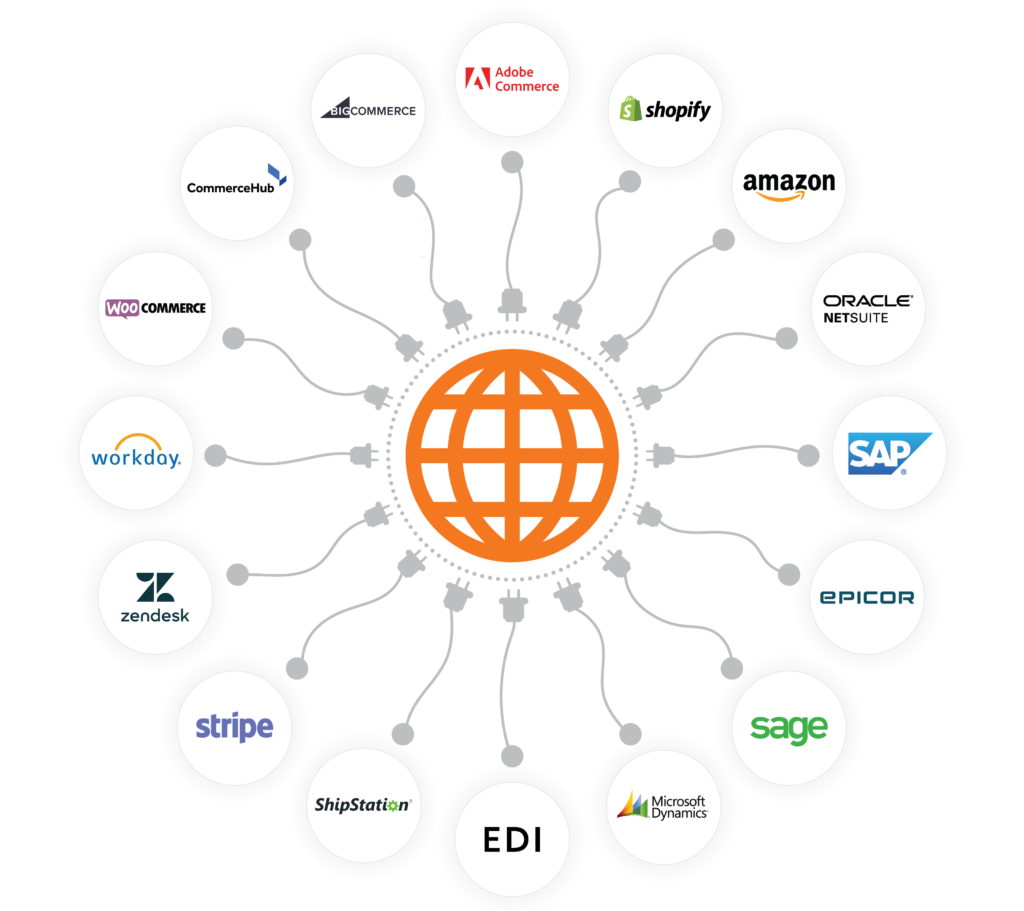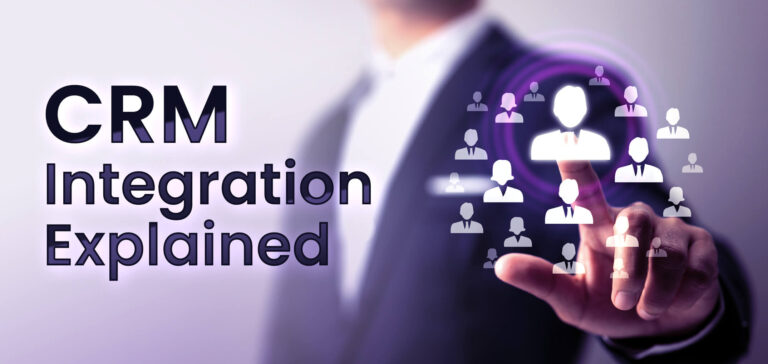By Dave Malda, Director, Ecommerce and EDI Integration Solutions
Defining what ecommerce integration is, why you need it, and how it streamlines workflows to create better buying experiences.
As customer needs and expectations evolve, so do the ways retailers sell, engage, and communicate with them.
Today’s commerce businesses are steadily adopting new channels to sell their products and increase their market share. For example, in-store businesses are now enhancing their online presence or leveraging marketplaces to sell their products, and ecommerce stores are turning to big-box retailers to increase brand visibility and stay ahead of the competition.
Regardless of strategy, leveraging integration and workflow automation technology provides the critical foundation needed to connect and synchronize customer data across various applications and channels along the buying journey.
With ecommerce integration, you can unburden your teams from manual work and ensure they can easily access the order, customer, product, and inventory data they need to foster better experiences and build brand loyalty.
What is ecommerce data integration?
Data integration refers to the process of connecting and synchronizing a company’s systems, channels, and applications to create a cohesive technology ecosystem, where data is automatically transferred back and forth between those systems.
Ecommerce integration involves connecting front-end web stores with other essential systems and applications, such as ERP systems, inventory management shipping systems, customer relationship management (CRM) software, and more, to facilitate a seamless customer experience from end to end.
What are common ecommerce integrations?
Here are six common ecommerce integrations that help improve both customer experiences and internal efficiencies:
-
Inventory management integration
Synchronizing your web store with inventory management systems, like NetSuite or Epicor, provides timely product availability and tracking. This prevents overselling, cart abandonment, and product listing errors to ensure accurate stock levels across all channels.
-
Order processing integration
Integrating ERP systems, like NetSuite or Microsoft Dynamics, with your web store streamlines the fulfillment process by automating order confirmations, tracking shipments, and updating order statuses in real-time.
-
Customer Relationship Management (CRM) integration
Connecting ecommerce platforms, such as Shopify, BigCommerce, VTEX, and WooCommerce, with CRM systems, like Salesforce and Microsoft Dynamics 365, provides a central hub to manage customer data, track support inquiries, and monitor sales cycles and implementation processes. With this data, teams and departments can improve the buying journey by measuring channel effectiveness and identifying process bottlenecks to optimize the overall customer experience.
-
Shipping and logistics integration
Integrating with shipping and logistics services ensures businesses fulfill orders efficiently and meet their shipping KPIs all while keeping customers in the know of where their products are and when they can expect them.
-
Marketing and analytics integration
Connecting ecommerce platforms with marketing tools and analytics solutions helps businesses track and analyze online browsing behavior, monitor the performance of marketing campaigns, and measure channel efficiency to identify opportunities for improvement.
-
Omnichannel integration
For businesses selling on multiple online platforms and via EDI trading partners (i.e. Costco, Home Depot, Best Buy, etc.), integrating these selling channels with the main ecommerce platform, ERP system, or CRM ensures consistency across systems when it comes to product information, pricing data, and inventory management.
Why do you need ecommerce integration?
Ecommerce integration is crucial for businesses that are adopting an omnichannel selling strategy, adding new systems and applications to their tech stack, or looking to automate manual processes while scaling their business. With an integrated ecommerce ecosystem, you can manage all your applications, from marketing and sales channels to the webstore to back-end ERP systems and CRM platforms, and access a holistic view of customer, product, inventory, and financial data – all in one location.
Every business is unique, of course, and there are a multitude of demands from stakeholders when it comes to integration. Some of the most common for implementing integration and automation solutions include:
-
Processing an influx of orders manually
As businesses add more selling channels, marketplaces, and EDI trading partners to their ecommerce arsenal, processing orders manually becomes even more difficult. This often leads to inaccurate orders, shipping mistakes, and overall workflow inefficiencies. If companies relying on manual processes attempt to offset these challenges by adding more staff, they often find it costly and ineffective.
-
Finding that scalability has limitations
When team members enter data by hand, successfully scaling your ecommerce business is virtually impossible. An increase in customers means more demand and higher expectations. With ecommerce integration, tasks like order processing, shipping, and inventory management are automated – giving team members the ability to focus on higher priority tasks and better serve your customers.
-
Struggling to deliver an exceptional customer experience
In many cases, support teams don’t have access to key data that can assist them as they help customers. Without a seamless data flow between your support systems to your CRM or ERP, you can cause extended wait times and slow down support resolution.
-
Dealing with a backlog of orders waiting to be processed
Be it a seasonal sale or a product promotion, businesses can easily fall behind in data entry, orders pile up, and customers have to wait for their purchases to be shipped as a result –leading to a poor buying experience and negative brand perception.
-
Hiring more data-entry staff is costly
Investing in more staff to perform data entry not only increases costs and takes time away from urgent customer matters, but it can also lead to more inaccuracies in order processing and management.
-
Keeping inventory records updated is difficult
Without a process in place for updating inventory records in real time, businesses run the risk of selling items that aren’t actually in stock. Plus, inventory levels need to readjust to account for processing returns.
-
Getting negative reviews
When customers are unhappy with slow services, poor communication, or faulty order processing, they won’t hesitate to write negative reviews online. Getting negative reviews may indicate it’s time to reassess your processes to identify key areas for improvement.
How to get your data ready for ecommerce integration
System integration involves a deep understanding of your data and the applications that provide that data. Knowing what transaction information is important helps you to identify the data processes you need to automate. The person setting up your organization’s e-commerce integration must have a solid understanding of the data that has to be involved.
Getting your business ready for integration involves two major steps:
-
Recognizing the types of data involved in processing an order
A seamless integration requires knowing the data points required to process an order successfully.
Some common order data includes:- Customer first name
- Customer last name
- Product ID
- SKU
- Customer email address
- Customer billing address
- Customer shipping address
- Customer phone number
- Product details (size, color, quantity, price, etc.)
- Shipping/tracking information
-
Cleaning your data
Cleaning your data can make the process of implementing your integration smoother and more efficient. Consider the following:
- Purge duplicate fields and customers. Having redundant data makes integration take longer
- Correct incomplete or inconsistent records. If you’re going to replicate data across multiple systems, make sure that data is accurate
- Ensure that your e-commerce platform, CRM application, and accounting or ERP system are updated
- If possible, add an accounting SKU in an extra field for each product in your ecommerce store
- Doing so reduces the number of translations needed
- Match selling units of measure with stock-keeping units of measure
- For example, if you sell a dozen pens in your store as one unit, make sure your ERP doesn’t reflect one unit as one individual pen
Performing these tasks will speed implementation, but don’t worry about getting your data into perfect shape. An expert integration provider can translate data for you.
How does Jitterbit’s solution help with ecommerce integration?
By connecting ecommerce applications, sales channels, and EDI to accounting systems, ERP systems, CRM, and 3PL, you’ll gain a complete view of the entire buying journey. Automate order to fulfillment processes and aggregate data from multiple touchpoints to drive innovation, eliminate manual processes, and create a consistent buying journey every time.
Our integration platform has pre-built connectors to key commerce platforms, EDI trading partners, and ERP or CRM systems that help accelerate the automation of common business processes with reusable, customizable, quick-to-implement, pre-built integrations.
With a connected and automated tech stack, powered by Jitterbit’s integration solution, you can:

-
Scale your business easily
Our ecommerce integration solution grows with you while you scale your business and add new applications and systems. With the proper integration strategy, technology, and vendor, you can more easily identify which systems you need and which systems you can do without.
-
Improve speed and accuracy
With ecommerce integration, you can automate the transfer of data between different applications to ensure more speed and accuracy when it comes to common workflows.
-
Create returning customers
By connecting your ecommerce platform and webstore to your ERP, warehouse management, shipping, and CRM systems, you can streamline complex post-purchase processes, such as returns or exchanges. In doing so, your customers will have confidence in your business and will be likely to return to your site to shop.
Why choose Jitterbit for ecommerce integration?
Jitterbit delivers powerful cloud-based integration solutions to automate your vital business processes and eliminate the need for manual data entry. You can connect any and all ecommerce marketplaces to your ERP, back-end system, and CRM through our integration platform. Additionally, pre-built connectors, recipes, and templates help to streamline the implementation process.
With decades of experience in the ecommerce space, Jitterbit has the capabilities and knowledge to help you grow and easily add more marketplaces, retailers, and applications to meet your changing business requirements. And when you need to create a custom integration or manage your Jitterbit integrations, we’ve got a team for that, too.







